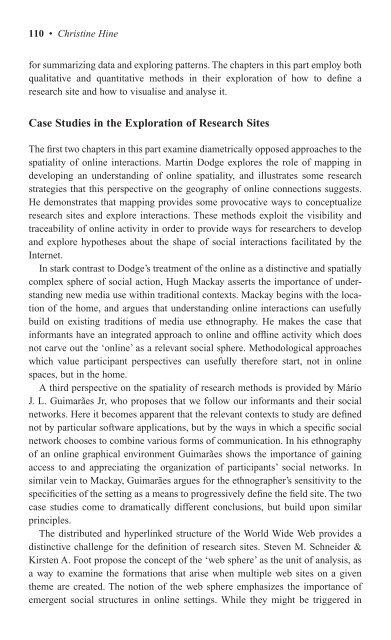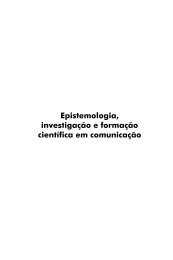Virtual Methods
Virtual Methods
Virtual Methods
Create successful ePaper yourself
Turn your PDF publications into a flip-book with our unique Google optimized e-Paper software.
110 • Christine Hine<br />
for summarizing data and exploring patterns. The chapters in this part employ both<br />
qualitative and quantitative methods in their exploration of how to define a<br />
research site and how to visualise and analyse it.<br />
Case Studies in the Exploration of Research Sites<br />
The first two chapters in this part examine diametrically opposed approaches to the<br />
spatiality of online interactions. Martin Dodge explores the role of mapping in<br />
developing an understanding of online spatiality, and illustrates some research<br />
strategies that this perspective on the geography of online connections suggests.<br />
He demonstrates that mapping provides some provocative ways to conceptualize<br />
research sites and explore interactions. These methods exploit the visibility and<br />
traceability of online activity in order to provide ways for researchers to develop<br />
and explore hypotheses about the shape of social interactions facilitated by the<br />
Internet.<br />
In stark contrast to Dodge’s treatment of the online as a distinctive and spatially<br />
complex sphere of social action, Hugh Mackay asserts the importance of understanding<br />
new media use within traditional contexts. Mackay begins with the location<br />
of the home, and argues that understanding online interactions can usefully<br />
build on existing traditions of media use ethnography. He makes the case that<br />
informants have an integrated approach to online and offline activity which does<br />
not carve out the ‘online’ as a relevant social sphere. Methodological approaches<br />
which value participant perspectives can usefully therefore start, not in online<br />
spaces, but in the home.<br />
A third perspective on the spatiality of research methods is provided by Mário<br />
J. L. Guimarães Jr, who proposes that we follow our informants and their social<br />
networks. Here it becomes apparent that the relevant contexts to study are defined<br />
not by particular software applications, but by the ways in which a specific social<br />
network chooses to combine various forms of communication. In his ethnography<br />
of an online graphical environment Guimarães shows the importance of gaining<br />
access to and appreciating the organization of participants’ social networks. In<br />
similar vein to Mackay, Guimarães argues for the ethnographer’s sensitivity to the<br />
specificities of the setting as a means to progressively define the field site. The two<br />
case studies come to dramatically different conclusions, but build upon similar<br />
principles.<br />
The distributed and hyperlinked structure of the World Wide Web provides a<br />
distinctive challenge for the definition of research sites. Steven M. Schneider &<br />
Kirsten A. Foot propose the concept of the ‘web sphere’ as the unit of analysis, as<br />
a way to examine the formations that arise when multiple web sites on a given<br />
theme are created. The notion of the web sphere emphasizes the importance of<br />
emergent social structures in online settings. While they might be triggered in



